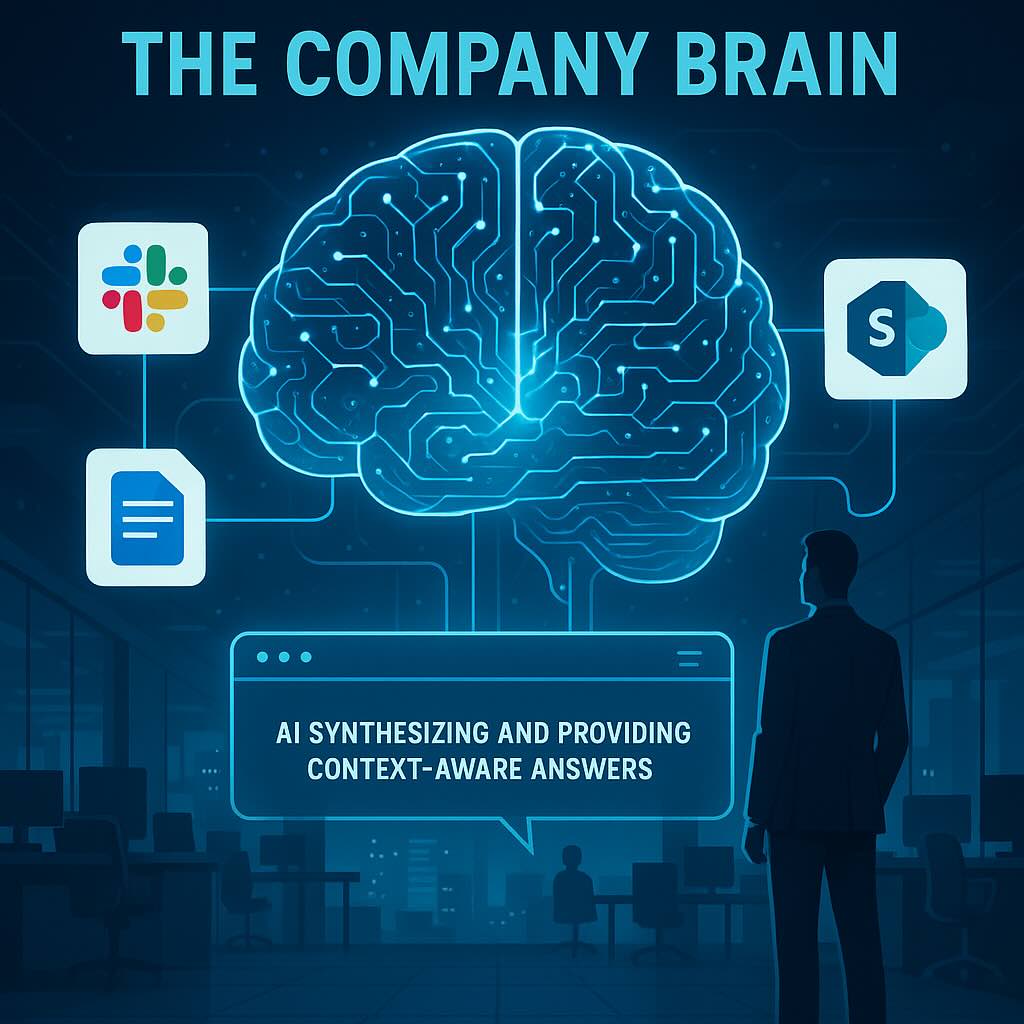3 AI Solutions That Actually Drive Business Value in 2025
Last time, I wrote about how AI has moved from "experimental curiosity" to "must-have business tool" in 2025. The question I keep getting from clients isn't "Should we use AI?" anymore. It's "What AI solutions actually work?"
After architecting AI solutions for myriad companies this year, I've identified several distinct patterns that consistently deliver results. While there are many approaches that work, I'm going to focus on three specific solutions that stand out as the clear winners. These aren't moonshot ideas or bleeding-edge experiments. They're practical solutions that consistently deliver measurable ROI across different industries and company sizes.
The Company Brain: Knowledge Base + AI Agent

The Problem: Your company's most valuable information is scattered everywhere. Slack channels, SharePoint folders, random Google Docs, institutional knowledge walking out the door when employees leave. Finding the right information takes forever, and synthesizing insights across departments is nearly impossible.
The Solution: A RAG (Retrieval-Augmented Generation) system that ingests all your company data and pairs it with an AI agent that can actually understand and synthesize information rather than just search for keywords.
This isn't just a fancy search engine. The AI can connect dots across documents, maintain your company's voice and tone, and provide context-aware answers. Need to onboard a new hire? The AI can pull relevant policies, team structures, and project histories. Writing a client proposal? It can reference past successful proposals and current company capabilities.
Getting Started: You can have a basic version running in 1-2 hours using ChatGPT Custom GPTs or Claude Projects. Upload your key documents, set some context about your company voice, and you've got an internal knowledge assistant. Scale up to dedicated platforms like Pinecone when you need enterprise security or larger document volumes.
The AI Thought Partner
The Problem: Knowledge work is increasingly complex, but most of us are still thinking in isolation. We need someone who knows both the business context AND our personal work patterns to help us process ideas, check our thinking, and spot blind spots.
The Solution: This is the evolution of the company knowledge base. An AI system that knows your company data but also learns your decision-making style, work patterns, and strategic thinking preferences. It's designed to work alongside you on specific tasks, from strategic brainstorming to financial analysis to project planning.
The key difference is personalization. This AI learns that you prefer data-driven arguments, tend to be overly conservative in financial projections, or always forget to consider regulatory implications. It adapts its recommendations accordingly.
Getting Started: Enable memory features in ChatGPT or Claude and consistently feed it context about your role, decision-making preferences, and company dynamics. Perplexity Pro works great for research-heavy thought partnership. The AI gets smarter about your needs over time.
Smart Automation Agents
The Problem: Traditional automation breaks down when processes involve variations, exceptions, or judgment calls. But there's a huge category of work that's "dynamic but repetitive." Tasks that require understanding context but follow predictable patterns.
The Solution: AI agents that can handle process automation requiring cognitive capabilities like interpreting meaning, recognizing patterns, and making judgment calls that rule-based systems can't handle.
Here are two examples I see delivering consistent high ROI:
Document Processing & Data Extraction
Processing insurance claims, loan applications, or vendor contracts involves understanding unstructured documents with varying formats, handwriting, and context. Traditional automation chokes on format variations and can't extract meaning from complex documents.
A global insurance company implemented an AI-driven document processing solution and reduced claim processing time by 80% while improving data accuracy to 99%. A leading healthcare provider digitized their patient records management, allowing them to extract critical data from handwritten notes and forms, resulting in a 60% reduction in manual data entry and a 40% decrease in processing costs. A large retail chain automated their invoice processing workflow, enabling them to process invoices 70% faster, reduce late payments by 90%, and reallocate staff to higher-value tasks, ultimately saving millions in annual operational costs.
Intelligent Lead Qualification & Routing
Determining which sales inquiries deserve immediate attention requires analyzing behavioral patterns, communication tone, company fit, and timing signals. Rule-based systems can't interpret intent from unstructured inquiries or predict conversion likelihood from complex data patterns.
Real estate companies implementing AI-powered lead qualification are seeing significant improvements in conversion rates through better matching of leads to appropriate agents based on specialties, availability, and geographic focus. The AI handles initial qualification calls, gathers key information, and automatically routes leads to the best-matched human agents, eliminating manual sorting and reducing time to first contact.
Getting Started: Zapier handles simple AI-powered automations between popular apps. Perfect for basic document processing and lead routing workflows. n8n works better for complex logic or custom integrations. Start with your most painful repetitive process and automate one piece at a time.
Implementation Reality Check
Pick the solution that addresses your biggest pain point, not the one that seems simplest. Document automation might be your easiest win if you're drowning in manual processing, while a knowledge base could be more complex than a basic thought partner setup.
The key insight: all three solutions can start small and deliver immediate value. A basic ChatGPT Custom GPT handling support questions beats a perfect enterprise system that never launches. Focus on solving one real problem well, then expand from there.
In 2025, it's no longer acceptable to use AI that isn't grounded in current, relevant data, whether that's live web search or your company's proprietary information. These three solutions give you practical ways to make that happen without boiling the ocean.
The companies winning with AI aren't the ones with the fanciest tech stack. They're the ones that picked the right problem, started simple, and iterated based on real results.
Tags

Dr. Randal S. Olson
AI Researcher & Builder · Co-Founder at Wyrd Studios
I turn ambitious AI ideas into business wins, bridging the gap between technical promise and real-world impact.